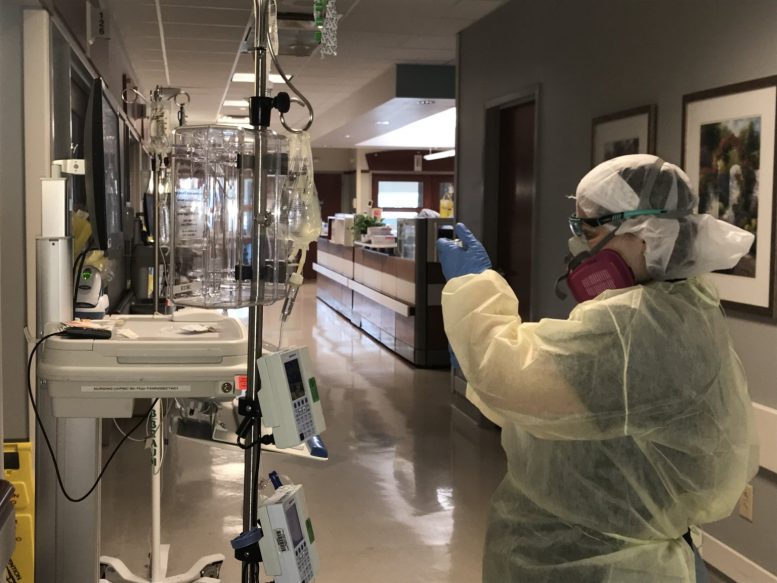In a pandemic dominated by testing shortages, Ohio exceeded a COVID-19 testing benchmark in September, state data shows.
Over prior months, Ohio has fallen short of testing estimates the Ohio Department of Health provided to the federal government.
In September, however, about 31,000 Ohioans received PCR tests for the new coronavirus, according to ODH data, compiled by the COVID Tracking Project.
That’s more than 15% above the estimate ODH provided to the U.S. Department of Health and Human Services. Ohio provided the federal government the projections after receiving congressional funds to be used to build a COVID-19 testing network.
Testing is critical in Ohio’s COVID-19 response. It’s the surest way to identify infected people and prevent them from spreading the virus. If someone is tested and receives a positive test result, contact tracers then determine who this person may have been near enough for a long enough period to have passed the virus on. Those people then seek testing, and the pandemic lifecycle continues.
Early in the pandemic, state and federal guidelines restricted access to test to older or immunocompromised people. Ohio fared poorly in coronavirus testing compared to other states.
However, data published by the New York Times shows Ohio in 17th in terms of state testing rates adjusted for population.
Modeling from the Harvard Global Health Institute, which measured infection rates and other factors, finds Ohio is one of 10 states running enough testing to control the epidemic.
As testing has increased, the seven-day moving average positivity rate (portion of those tests that come back positive) has decreased from as high as 6.4% in July to 3.2% on Sunday, the latest data available.
The higher the positivity rate, the higher the likelihood that cases in the population are going undiagnosed.
Last week, ODH released serology data, collected during a July case surge, suggesting COVID-19 is much more prevalent than official data shows.
ODH predicted about 120,000 Ohioans would be able to receive antibody tests, which detect past infections, per month in September. That figure is estimated to rise to 300,000 in October. An ODH spokeswoman did not respond to requests for antibody testing data.
If a person receives a positive antibody test and either reports symptoms or exposure to a confirmed case, he or she is counted as a “probable” case.
Gov. Mike DeWine has said two large batches of antigen tests, which are less accurate but faster and cheaper than PCR tests, are coming soon to Ohio, though details are scant.
In August, DeWine joined with governors from five other states to secure 3 million antigen tests. However, it’s unclear how many of those tests Ohio will receive and how they will be deployed.
A DeWine spokesman said Tuesday he did not have more detail to provide.
Similarly, HHS announced in late September that it would send 150 million point-of-care antigen tests out to states. Again, details remain hazy.
The beefed-up testing arrives at a critical moment: Tuesday data shows an uptick in cases and current hospitalizations continue.
All told, more than 161,000 Ohioans have been infected with COVID-19. Of them, nearly 16,000 have been hospitalized and 4,947 have died.
***
Also from Ohio Capital Journal:
Mail-in ballots are safe from fraud, but other aspects of election system are vulnerable to attack

This is the third in a series of stories looking at voters’ concerns and voting issues in the 2020 election. Tomorrow: A court decision guts the Voting Rights Act.
There is no evidence, despitepartisan claims to the contrary, that mail-in ballots are rife with voting fraud — but there are parts of the election system that security researchers say are at far greater risk for malicious activity.
National elections like the one in November, when Americans will decide whether Donald Trump or Joe Biden will lead the country for the next four years, are really thousands of smaller elections administered by state and county governments. And each of those governments has its own procedures for ensuring ballot and information security, and for purchasing, maintaining and testing the equipment that it uses to conduct its election.
For instance, even though more than 30 states allow overseas voters to cast their ballots by email, fax or through other electronic means, there are no standards for even basic security measures like encryption. In Ohio, no voted ballot may be returned to a board of elections by fax or e-mail. If a voted ballot is returned by fax or e-mail, it will not be accepted, processed, or counted. READ MORE





